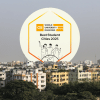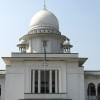Heartbreak at Sadarghat

Last week I went to Sadarghat with my team to work on a documentary on Dhaka's urban story. We arrived at the launch terminal in the wee hours, just when launches arrive from the country's riverine south. The terminal was quite a sight. Passengers—exhausted, excited, worried, curious, young, old, male, female, traders, rural relatives—disembarked from their marine vehicles and hurriedly entered the jadur shahar. Some people carried their ducks, chickens, household stuff, sacks, and luggage of all shapes.
The big boats, with fanciful names, arrived from Barishal, Patuakhali, Boga, Golachipa, Barguna, Amtali, Tushkhali, Chandpur, Dhulia, Nurainpur, Kalaia, Monpura, Hatia, Bhola, and other places. They docked at the terminal with practically no space in between them. Despite the frenzy of the place, rows of docked launches, their hulls jutting out over the terminal platform, created a rhythmic pattern. The siren of the boats, noise, passengers streaming out, vendors, terminal tokais—all created a frantic scene that we sought to capture through the eyes of our camera.
The terminal felt like an Indiana Jones stereotype of an oriental bazaar, an expected spectacle at Dhaka's maritime gateway. After spending quite a bit of time at the terminal, we climbed on the roof of a large launch to catch an aerial view of the terminal, as well as the river and its banks.
We witnessed a devastating scene. All the launches that arrived a little while ago were being cleaned. The cleaning staff amassed the garbage on the deck and simply threw everything into the river, as if it were a drain to flush out the litter—of both the launch and our moral failures. From paper cups, plastic bottles, and all kinds of junk to even vomit, everything was dumped into the river.
Now consider this. Approximately 200 large and small passenger launches arrive at, and depart from, the Sadarghat terminal every day. The officials there estimate that 30,000 people on average pass through the terminal every day. How much waste are we then dumping into the river every day, right there at the terminal? Is there anybody to monitor the river rot?
And, of course, the Buriganga River doesn't have a voice to protest this sheer environmental injustice.
Launch-waste dumping into the river was not the end of our story. Scavengers were already waiting in small boats to fish out the recyclables, especially plastic bottles. Our further inquiries revealed that the boatful of bottles plucked from the river are then supplied to the terminal tokais or the poor boys of Sadarghat. They clean up the collected bottles with as minimum water as possible and then fill them up with water from dubious sources to sell to the passengers who would catch a launch in the evening. Their daily average income from this "business" is around Tk 200. We videotaped the terminal boys in action, participating in this ironic tale of "recycling."
This is one of the stories of the river-based informal economy in Dhaka, sadly bringing to the fore a jumbled narrative of environmental insensitivity, river pollution, recycling, survival, poverty, and child labour. At the end of the day, the key question, however, is: Why do we treat our rivers with such little respect?
Rivers are this deltaic land's lifeline. Rabindranath Tagore's Our Little River that flows in "graceful loops" through pastoral Bengal may be a short poem but it encapsulates the region's entire river ecology, its hydraulic genius loci, across the seasonal spectrum, from the summer heat to the "festival of rain." Rivers are Bengal's epic stories, engraved on the delta.
Yet, we treat rivers and canals like dumping grounds or "lands" to be occupied. A 2010 report estimates that approximately 250 tanneries, located at Hazaribagh on the bank of the Buriganga River, produced 25,000 tons of solid waste and 40,000 tons of toxic liquid waste every day, most of which were dumped into the Buriganga.
The government understood the severity of the situation and took strong initiatives. The Bangladesh Small and Cottage Industries Corporation (BSCIC) has allotted 205 plots inside a 200-acre industrial park at Savar for relocation of the Hazaribagh tanneries.
Even though some observers state that the water quality of the Buriganga has improved a bit after the tanneries left Hazaribagh, a bigger threat still remains: our national attitude toward rivers and canals in our everyday life. The Buriganga and other rivers of Bangladesh continue to suffer irredeemable damage due to our general environmental apathy. Hazaribagh tanneries may move to another location, but how are we, the public, better than the polluting industries?
Waste-dumping at the Sadarghat terminal is one example of how we habitually disrupt the ecological wellbeing of our rivers and canals. It is an enigma to me that we, the people of a fragile land-water geography, generally do not value the environmental significance of our rivers. We rarely feel any ethical qualms when we throw plastic bottle into the river. The cleaning crew of Sadarghat launches didn't seem to think for a second that plastic bottles and other litter would damage the ecology of the river, even at a micro-scale. The harm may occur at a small scale, but the culturally-ingrained public carelessness that enables it is a far greater threat than tanneries without effluent treatment plants.
How do we change the public attitude toward our precious rivers and waterbodies? Should we use popular culture? Media? Slogans that become part of our national consciousness? I recall how effective the advertisement—chhele hok, meye hok, duti shontan-i jothesto (boy or girl, two children are enough)—was during the 1980s. Environmental laws are there but do we have the institutional capacity or the policy mindset to implement them? Should we create a new cadre of river police? How do we tame our insatiable demand for land?
We took a boat ride on the Buriganga that day. Just a five-minute boat-ride away from the Sadarghat terminal, it was ironic to see a large slogan on the side of the Buriganga Bridge: "The river is our mother. Let's protect her." The slogan, written in bold white letters set against a pure red backdrop, was inspiring. It seemed to have elevated the bridge from its utilitarian state to the level of a sublime urban artwork. I was deeply touched by it and appreciated the government agency that thought of it as a mass-awareness building tool. I craned my neck to touch the water of the Buriganga. A few plastic bottles flew past my wet hand.
Adnan Morshed, PhD, is an architect, architectural historian, and urbanist, and currently serving as Chairperson of the Department of Architecture at BRAC University. He is also the executive director of the Centre for Inclusive Architecture and Urbanism at BRAC University. His recent books include DAC/Dhaka in 25 Buildings (2017) and River Rhapsody: A Museum of Rivers and Canals (2018). He could be reached at [email protected].










Comments